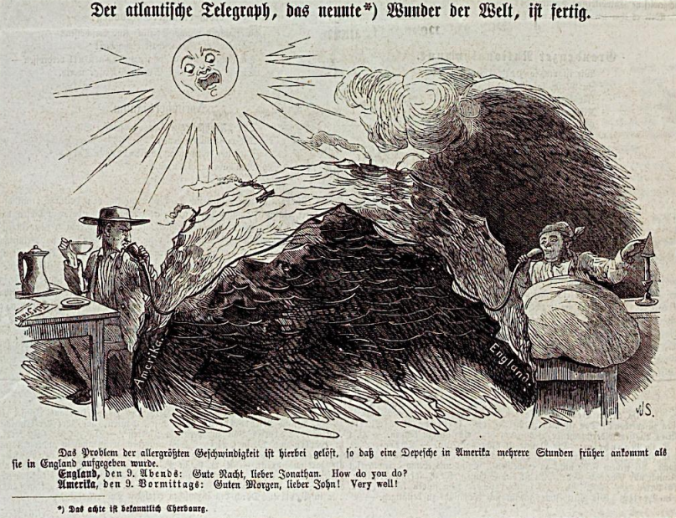Confusing Times: Communicating, 24/7

Source: Universitätsbibliothek Heidelberg, Kladderadatsch, 22 Feb. 1857, p. 36 – CC-BY-SA 3.0
In the age of smartphones, broadband internet access, and cheap(ish) air travel, the vision of the ‘global village’, appears to have become a reality. Networks of communication and transportation ensure that work and social life can remain uninterrupted, as those of us privileged enough to benefit from new technologies become—potentially—contactable anytime, anywhere. In the virtual world, video conferences and phone calls take place around the clock, maintaining business relations and friendships across the globe. In the physical world, distance remains an obstacle, but meetings are scheduled at increasingly short notice, as an ever growing number of flights carry passengers from one end of the world to the other, at all times of the day and night.
The roots of this global 24/7 society can arguably be traced back to the introduction of telegraphy during the nineteenth century. Only from the late 1840s and 1850s did networks of communication begin to extend across entire states, continents and, eventually, the globe, allowing a steadily expanding group of users to exchange messages over considerable distances, and instantaneously—at least, in theory. In practice, the cost of inter-continental telegrams long remained prohibitive, and technological limitations often meant that communication was interrupted or delayed. But the idea that diplomacy, business, news reporting, and even social interactions could be conducted across the globe in ‘real time’ both fuelled and confused the contemporary imagination.
Already in 1857, the German economist Karl Knies sketched out the implications of instant messaging for people’s understanding of time. Considering ‘a telegraphic dispatch which is sent eastwards and arrives “in the blink of an eye”’, he wrote, ‘the further it travels, the later it arrives—compared with the time at the sending office; and one which is sent westwards must arrive increasingly “earlier” than when it is sent’. Anticipating the imminent establishment of a telegraphic connection between Europe and North America, he explained that if ‘a message in Washington, New York or Philadelphia arrives five hours “earlier” than it is sent from London, Amsterdam or Paris, it overtakes the “course of the sun”, and puts into question a number of practical matters of everyday life”. For the first time, Knies explained, ordinary individuals would have to be attentive to the date in different places across the world: ‘next to the “today” in our Europe there is a “yesterday” in Asia, and a “tomorrow” in America’.[1]
A year later, the first trans-Atlantic cable was laid between Ireland and Newfoundland, sparking a fascination for the ‘contemporaneity’ of different days and times. The German satirical newspaper, Kladderadatsch, immediately seized on the opportunity to play with the temporal disorder which the telegraph appeared to cause. An article entitled ‘The Wonderful Effects of the Transatlantic Telegraph’ presented a sequence of imaginary exchanges, which began with a telegram received in Quebec, on 10th June 1860, at 5 am, announcing that a fire had broken out in the Tower of London at 10 am that day. The message was immediately transmitted to Nikolayevsk-on-Amur, in Eastern Russia, where it arrived on 9th June at 10pm, local time, and from there was sent to Moscow.
Upon receiving the news of the fire, the article continues, the police chief in Moscow promptly telegraphed the Lord Mayor of London, at 4pm on 9th June (local time), describing the alarming message ‘which we have just received from America, sent tomorrow morning from London’. ‘Thanks to the wonderful head-start which the telegraph provides’, the police chief added, ‘I hope you will be in a position to prevent the imminent danger’. The Lord Mayor of London finally replied, at 1 pm on 9th June: ‘Thanks, a thousand thanks! Your zeal will save us. The fire services have been alerted, the fire engines are being driven past the site and tested, such that we can hope to extinguish the fire tomorrow morning as soon as it breaks out’.[2]
One hundred and sixty years on, this early fascination with the impact of a now defunct technology may seem almost endearing. Yet the temporal confusion which accompanied the early experience of telegraphic communication has by no means disappeared in the face of increasing global integration. How many of us ask ourselves, as we board a long-haul flight, ‘At what time do I land? And what time will that be in my mind?’, as we plan a strategy to adapt our body clock to local time upon arrival. How many urgent emails are put on hold or lie unanswered because our partners across the pond ‘aren’t awake yet’? Many are the long-distance calls, conferences and interviews, which are planned in advance to suit the habits of individuals in different time zones—heaven forbid one of them should switch to Daylight Saving Time in the interim—only to then begin with the question: ‘so what time is it where you are then?’
Whilst the telegraph lay the foundations of the perpetually connected world in which many of us live, it also first demonstrated the social and biological limits to global synchronisation. As a cartoon published in Kladderadatsch illustrated, the laying of the trans-Atlantic cable in 1858 heralded the age of instantaneous communication—it augured a world kept awake by the pulse of the network. But it also highlighted the many social rhythms and diurnal cycles that co-existed across the globe—frameworks of activity with which the tempo of communication would have to compete. The scene depicted is reminiscent of many a present-day Skype conversation, scheduled at the fringes of two individuals’ days, confronting the bleary-eyed bed-goer with the fresh alertness of the early bird: ‘Good Night, dear Jonathan. How do you do?’, the Englishman asks his American friend. ‘Good morning, dear John! Very well!’[3]

Source: Universitätsbibliothek Heidelberg, Kladderadatsch, 22 Aug. 1858, p. 156 – CC-BY-SA 3.0
[1] Karl Knies, Der Telegraph als Verkehrsmittel (Tübingen, 1857), pp. 190-1.
[2] Universitätsbibliothek Heidelberg, Kladderadatsch, 29 Aug. 1858, p. 158.
[3] Universitätsbibliothek Heidelberg, Kladderadatsch, 22 Aug. 1858, p. 156.



